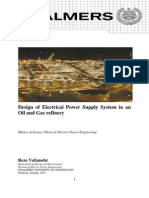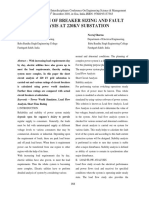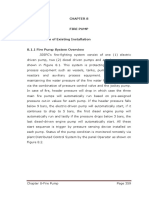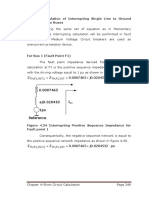CHAPTER 1 Introduction
1.1 Project Overview
JG Summit Petrochemicals Group (JGSPG) consists of
JG Summit Petrochemical Corporation (JGSPC) and JG Summit
Olefins Corporation (JGSOC) which are both wholly owned
subsidiaries of JG Summit Holdings, Inc (JGSHI). JGSPG has a
250-hectare
fully
integrated,
world-class,
PEZA-accredited
manufacturing complex in Brgy. Simlong, Batangas City, 120
km south of Manila.
JG Summit Petrochemical Corporations has three (3)
polymer plants namely Polyethylene 1, Polyethylene 2 and
Polypropylene
which are
currently
producing
a combined
capacity of 510 kTA of resins per year.
On the other hand JG Summit Olefins Corporation is
producing polymer grade Ethylene and Propylene that are both
exported overseas and used by JGSPC as its main raw material
for producing PE and PP resins.
Power to the entire petrochemical complex is coming
from its own 74MW Diesel power plant located inside the
complex. The power plant also increases its capacity from its
original rating of 47MW through additional generating units.
From 2011 to 2014, PE plants undergo a major debottlenecking project (PE Expansion Project) to increase the
capacity from 200kTA to 320kTA. The Basic Engineering was
handled by JGSPCs Project Engineering group which the author
was part of the team and with its technology vendor from US
while
Detailed
Engineering,
Project
and
Construction
Management were handled by Toyo-Thai Engineering PTE LTD
of Thailand.
Part of the PE Expansion project was the expansion of
the existing substation to cater the additional load requirement
Chapter 1-Introduction
Page 1
�such as motors, lightings, instrument and control systems and
process heaters. These additional loads have a combined total
capacity requirement of about 33.3MVA which the existing
substation cannot cater.
Construction of the said plant has been completed last
April 2004 while pre-commissioning, commissioning and startup
activities were completed last June 2014.
Figure1.1 JGSPC (front) and JGSOC (back) Complex
The
substation
of
interest
consist
of
52MVA
13.8kV/6.9kV Delta-wye (solidly grounded) transformer, two(2)
x
3MVA
6.9kV/480V
Delta/wye
transformer,
MV
6.9kV
switchgears, five(5) large induction motors, Power factor
correction capacitors and two(2) spare feeder intended for
future requirement (see Figure 1.2 for Single Line Diagram).
Chapter 1-Introduction
Page 2
Generator
8 sets
8.375MVA
13.8kV
Bus 1
NEW
Polyethylene
Plant no. 2
Estimated equivalent Loads
Momentary:
Z=0.000639 + j 0.019257
p.u (10MVA base)
TRM1
40/52MVA
13.8kV/6.9kV
Interrupting:
Z=0.000685 + j 0.021452
p.u (10MVA base)
Bus 2
TRL3A
3MVA
13.8kV/480
M
PE-KM5806 PE-YM7601
540W
4850W
6.9kV
6.9kV
TRL3B
3MVA
13.8kV/480
PE-KM8601 PE-KM8639
250W
315W
6.9kV
6.9kV
Bus 3
Bus 4
Figure 1.2 System Single Line Diagram
1.2
Project Objectives
This technical report has the following objectives
1.
To determine the positive, negative and zero
sequence impedance network and admittance models from
the point of connection Power Plant Bus (BAC908), Power
transformers and loads;
2.
To perform load flow study by determining the
bus voltages, Load terminal voltages, voltage drop, power
flows, current flow and power factor from Power plant bus
(point of connection) up to each 480V loads;
3.
To perform analysis on the load flow result and
provide recommendation for system improvement.
Chapter 1-Introduction
Page 3
�4.
To perform short circuit study for both momentary
and interrupting three(3) phase fault, single line to ground,
line to line and double line to ground fault from the point of
connection at the power plant up to each 480V loads and
determine the minimum and maximum fault current at each
protective devices connection points;
5.
To perform motor starting analysis for medium
voltage motors and low voltage motors that are 100kW and
above by determining the impact of each motor starting
scenario to the power system and evaluate each big motors
starting performance;
6.
To design the time-current coordination of the
overcurrent protective devices and motor overload protective
devices.
1.3
Project Scope and Limitations
As depicted in figure 1.2, this power system study will
from the JGSPCs Power Plant connection point at BAC908
13.8kV feeder, up to the 480V loads. As summarized on table
1.3.1 Load flow study will be conducted from the BAC908
feeder, the 52MVA power transformer, the 6.9kV Motor loads,
the 2 x 3MVA transformer and its 480V loads. Short circuit study
covers from the downstream of BAC908 up to 480V loads. The
Equivalent momentary and interrupting fault impedances at the
connection point were already provided by an earlier study of
the original power system before the PE plant expansion. This
equivalent model will be utilized in the short circuit analysis.
Chapter 1-Introduction
Page 4
�Table 1.3.1 Summary of Study Coverage
Analysis Type
Coverage or scope
Load Flow Study
From BAC 908 down to all PE2
power system up to 480V loads
Short Circuit Study
Fault point at TRM1 primary and
secondary, 6.9kV bus, 6.9kV
loads, TRL3A/B primary and
secondary, 480V bus and 480V
loads
Device Coordination Study
From BAC 908 protection down
to all the protective devices of
PE2 power system.
Large Motor Starting Study
Chapter 1-Introduction
All motors 100kW and above
Page 5
�Table 1.3.2 Summary of Sub-Study Area
Analysis Type
Sub-Study Area
Power
System 1. Impedance model
Model
2. Admittance Model
3. Load Model
Load Flow Study 1. Bus voltage and Load Voltage Calculation
2. Current and Power Flow Calculation
3. Voltage Drop Calculation
4. Power Factor Calculation
5. Voltage Drop Evaluation
6. Transformer and Bus Bar Loading Evaluation
7. Power Flow Evaluation
Short
Circuit 1. 3-phase fault at various location (Momentary
Study
Symmetrical, Asymmetrical and peak)
2. SLG Fault at various location
3. Line to Line Fault at various Location
4. Double
Line to ground fault
at various
location
Device
1. TCC coordination of all MV Loads and critical
Coordination
Study
Large
LV Loads
2. Grounding System Evaluation
Motor 1. Motor Starting Analysis
Starting Study
Chapter 1-Introduction
Page 6































































































